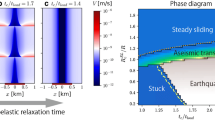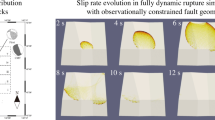Abstract
— We have simulated a rupture transition from quasi-static growth to dynamic propagation using the boundary integral equation method. In order to make a physically reasonable model of earthquake cycle, we have to evaluate the dynamic rupture propagation in the context of quasi-static simulation. We used a snapshot of the stress distribution just before the earthquake in the quasi-static simulation. The resultant stress will be fed back to the quasi-static simulation. Since the quasi-static simulation used the slip-and time-dependent constitutive relation, the friction law itself evolves with time. Thus, we used the slip-weakening constitutive relation for dynamic rupture propagation consistent with that used for the quasi-static simulation. We modeled a San Andreas type strike-slip fault, in which two different size asperities existed.
Similar content being viewed by others
Author information
Authors and Affiliations
Additional information
(Received February 20, 2001, revised June 11, 2001, accepted June 25, 2001)
Rights and permissions
About this article
Cite this article
Fukuyama, E., Hashimoto, C. & Matsu'ura, M. Simulation of the Transition of Earthquake Rupture from Quasi-static Growth to Dynamic Propagation. Pure appl. geophys. 159, 2057–2066 (2002). https://doi.org/10.1007/s00024-002-8723-x
Issue Date:
DOI: https://doi.org/10.1007/s00024-002-8723-x




